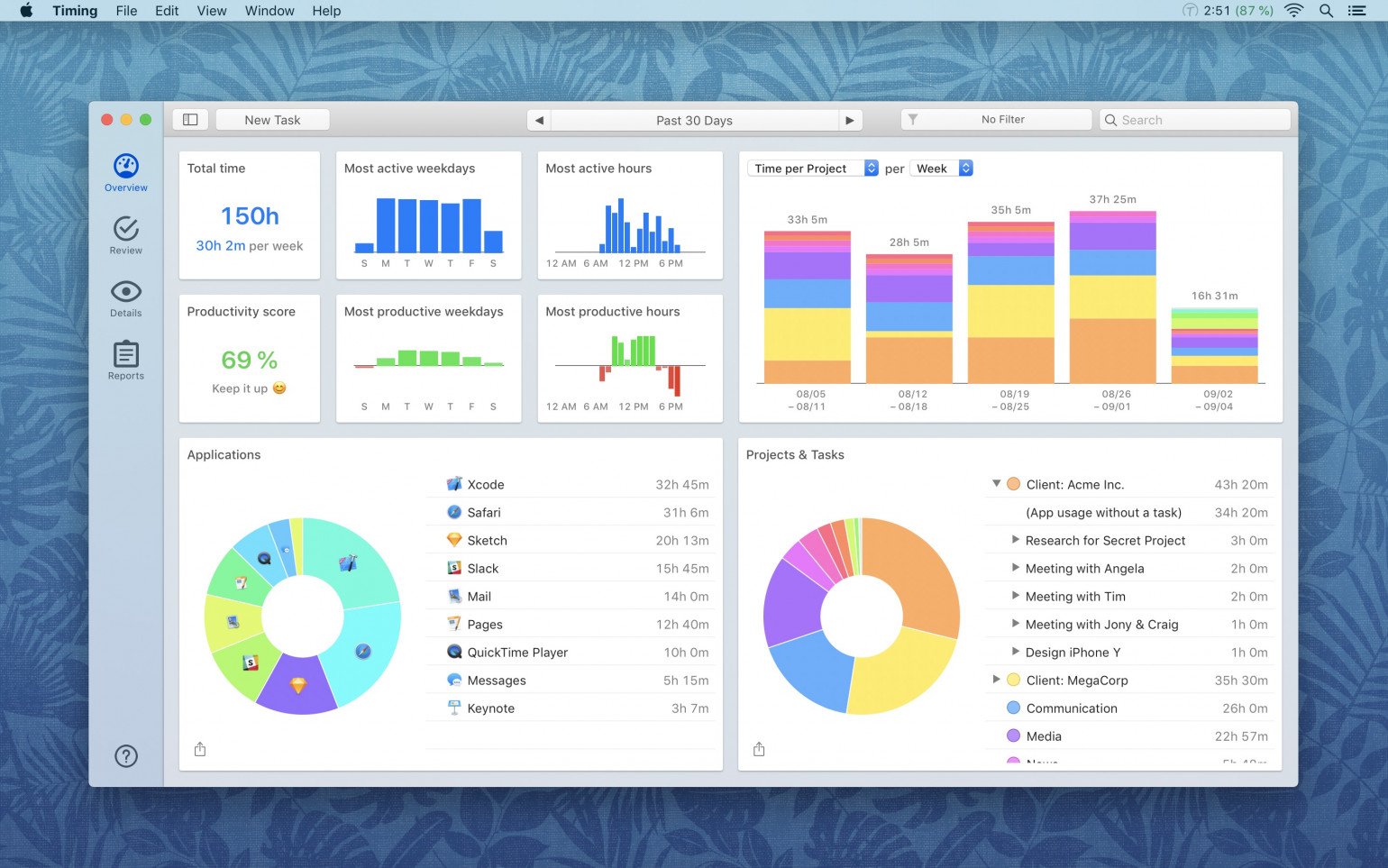Time-Tracking Hacks for Students

One of the many joys of being a student is managing your own time. If you’re a night owl, you can study until 2 AM and sleep in. If you’re an early bird, you can front load all your work into the first half of your day, and be finished by 1 PM. But time management for students can be tricky, especially with distractions from your social life, extracurriculars, and more.
Thankfully, there are hacks to time management that still help you create the lifestyle you’re looking for. These strategies can even raise your grades, help you meet your academic goals, and cut down time spent in the library.
Time Management Starts with Time Tracking
Effective time management begins with time tracking: It’s all about strategically monitoring your own minutes and hours to gain greater awareness of just what you’re doing with your time. For example, you might find that you’re spending 10+ hours a week studying for Spanish, but only 5 hours studying Microbiology. Is that imbalance reflected in your grades? Or you might find that you’re spending way more time on YouTube than you thought on your self-appointed “study breaks.”
If the thought of strategically remapping your schedule feels overwhelming, don’t stress out quite yet. There are time-tracking hacks that can kickstart the process of successfully managing your time, and it won’t be long before you start seeing great results (better grades, more spare time, and improved self-care — who doesn’t want that?).
Make a List of Priorities
There are only 24 hours in a day, and you can only achieve so much. Plus, everyone needs to sleep.
That’s why successful time-tracking begins with prioritizing your work and activities. Making a list gives you a powerful visual of how your priorities stack up, and it can serve as a reference point when it comes time to review your time-tracking (we’ll get there in a minute).
Think through which classes or projects critically need your attention. These are classes that could have a significant impact on your GPA or relate to your major. These subjects will go at the top of your list. You’ll want to take steps to ensure that you’re giving an appropriate amount of time and focus to these classes. A tool like Studocu can help bring structure to your educational files, providing easy access to course materials, notes, and assignments, thus helping you stay organized and succeed in your studies.

That being said, you won’t want to let your other classes and subjects fall by the wayside. Successful prioritization doesn’t mean you allow one task, subject, or project to succeed at the expense of others. As you choose subjects and classes for slots #2, #3, and #4, think through how much effort you require to be successful at various subjects.
Finally, include self-care on your list of priorities. It can be easy to feel like you should be occupied and productive every second of every day. But making room to rest and be mindful can ultimately help prevent burnout; in the long term, taking time to refuel is essential to maintaining your success as a student.
Use an Automatic Time-Tracking App
You can certainly try to track your own time by using a basic note application, or even a pen and paper. But to get accurate, detailed results, you’ll need to use an app that automatically tracks your time.
Categorize Your Time with Timing
Timing is an automatic time-tracking app that monitors every minute you spend on your Mac so that you have a detailed report of your activities at the end of every day, week, month, or year. It will break down how you spent your minutes and hours on various applications and websites. “Offline work” — such as studying from a textbook or handwriting assignments — can be manually input as a “task.”
Here’s what the Overview tab looks like, which you can check regularly to monitor your productivity:

Under the Review tab, you’ll create “tasks” for offline work, which will automatically be accounted for in your overall results.
You can also create categories or “projects” for different classes or subject areas. At the end of the day, drag and drop different activities into your class/subject categories; this visual mapping will help you to see how much time you’re spending overall on each class. Timing will also identify common keywords to help you automatically categorize your time usage. For example, if the keyword “20th century” is often used in your work for a history class, you can drag and drop that keyword into your class category. Timing will then instantly assign any work involving the term “20th century” to that class.
Timing will also show you exactly when you were studying for Microbiology, writing a paper for Art History, or even shopping for new shoes on eBay. Finally, it will assign you a productivity score, showing you what parts of the day you were most focused and in the flow.
Review Your Results
Try using Timing for one week without making any significant changes to your schedule. Now, review. Are you surprised by the results? Maybe the research paper that felt like it took 10 hours actually only took 6.5 hours to complete. Possibly, you’re spending more time than you realized on lower-value assignments. Lastly, you might note that you’re particularly productive between the hours of 11 AM and 1 PM.
Now, compare your results to your list of priorities. Are your academic priorities accurately reflected in your time usage? If not, consider how to shift around your time to better focus on classes that critically need your attention.
Maximize Your Calendar Usage
More than likely, you’ve got a class schedule that varies from day-to-day. Bio lab at 9 AM on Tuesdays? Lecture for Modern Art on Thursday night at 8 PM? Discussion group meeting for American history on Friday afternoon at 2:30 PM? You need to keep it all straight — and account for it in your time-tracking results.
Timing will actually sync with your calendar, so that you can automatically time-track the periods spent in class along with your hours spent studying, writing, and researching. And, if you need to, you can manually input offline extracurricular activities to account for those too.
Evaluate Time-Sucks and Distractions
Now that you’ve learned how to use Timing to review, categorize, and even schedule your time usage, you’ll need to take a good hard look at “time-sucks.”
We’re all susceptible to time-sucks. When we don’t have a boss (or teacher) watching over our shoulder, it’s easy to turn a 5-minute break on the Internet into an hour-long YouTube marathon. Take an honest look at your time usage to see how time-sucks on your computer could be distracting you from real, valuable work. Now, take steps to block those distractions.
If it’s the case that your iPhone is the culprit, then use Screen Time to block app usage or monitor your phone usage (by the way, the Timing app is also mobile-friendly). Or you can use Screen Time on your Mac to limit website usage.
You might also note that you get more productive work done in certain locations. If you notice that your mornings are more productive when you work in the library, then spend more time in the library. If late nights in your dorm room don’t seem to produce great results, try finding another study location.
Acting on Your Feedback
Once you’ve completed the steps outlined above, you’ll have plenty of insight into your time usage. You’ll have shifted study habits around, learned to review your time usage at the end of each day, and blocked distractions that are robbing you of minutes and hours that should be spent studying. Maybe you’ll even have cut down on the time you spend studying overall, learning how to become more focused and goal-oriented in your work.
Using time-tracking will help you become more productive — not busier. Share on X When you learn to be more efficient, you should be able to create more free time for rest and relaxation, extracurricular activities you enjoy, and spending guilt-free time with friends. Your time will be more focused and produce a higher output, improving your academic performance. And you’ll have developed a useful skill for managing your own time in order to successfully meet your goals.
